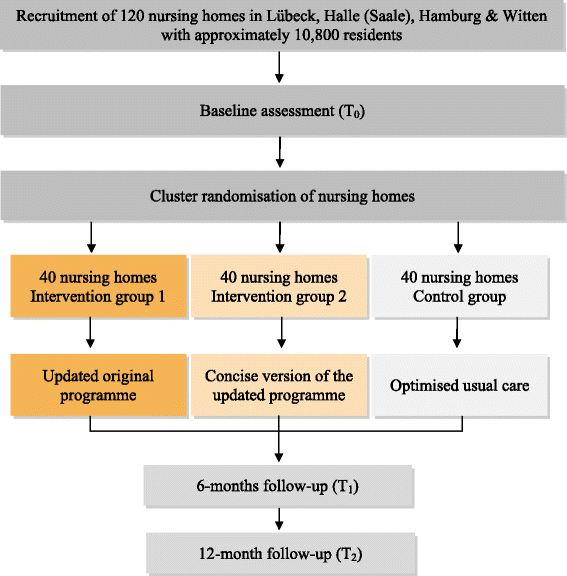Implementation of a Multicomponent intervention to Prevent Physical Restraints In Nursing home residenTs (IMPRINT): study protocol for a cluster-randomised controlled trial
- PMID: 26195247
- PMCID: PMC4509466
- DOI: 10.1186/s12877-015-0086-0
Implementation of a Multicomponent intervention to Prevent Physical Restraints In Nursing home residenTs (IMPRINT): study protocol for a cluster-randomised controlled trial
Abstract
Background: Physical restraints such as bedrails and belts are regularly applied in German nursing homes despite clear evidence showing their lack of effectiveness and safety. In a cluster-randomised controlled trial, the efficacy and safety of a guideline-based multicomponent intervention programme has been proven. The present study aims to evaluate the effectiveness of two different versions of the original intervention in nursing home residents in four different regions throughout Germany.
Methods/design: The study is a pragmatic cluster-randomised controlled trial comparing two intervention groups, i.e. (1) the updated original multicomponent intervention programme and (2) the concise version of the updated programme, with a control group receiving optimised usual care. The first intervention group receives an educational programme for all nurses, additional training and structured support for nominated key nurses, printed study material and other supportive material. In the second intervention group, nurses do not receive education as part of the intervention, but may be trained by nominated key nurses who have received a short train-the-trainer module. All other components are similar to the first intervention group. The control group receives the printed study material only. Overall, 120 nursing homes including approximately 10,800 residents will be recruited and randomly assigned to one of the three groups. The primary outcome is defined as the proportion of residents with at least one physical restraint after 12 months follow-up. The use of physical restraints will be assessed by direct observation. Secondary outcomes are the residents' quality of life and safety parameters, e.g. falls and fall-related fractures. In addition, comprehensive process and economic evaluations will be performed.
Conclusions: We expect a clinically relevant reduction in the proportion of residents with physical restraints. It is also expected that the process outcomes of this trial will enrich the knowledge about facilitators and barriers for the implementation of the multicomponent intervention programme.
Trial registration: ClinicalTrials.gov: NCT02341898.
Figures
References
-
- Tang WS, Chow YL, Koh SSL. The effectiveness of physical restraints in reducing falls among adults in acute care hospitals and nursing homes: a systematic review. JBI Libr Syst Rev. 2012;10:307–51. - PubMed
-
- Bleijlevens MH, Wagner LM, Capezuti E, Hamers JP. A Delphi consensus study to determine an internationally acceoted definition on physical restraints. Symposium, 65. GSA Annual seintific meeting November 14th-18th, 2012, San Diego. Geront. 2012;52(s1):136.
Publication types
MeSH terms
Associated data
LinkOut - more resources
Full Text Sources
Other Literature Sources
Medical


